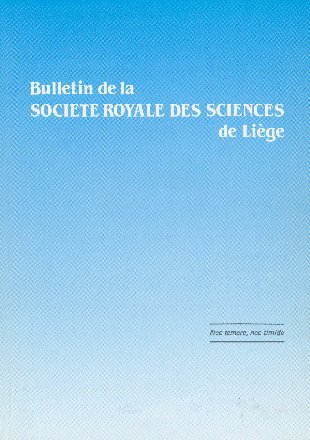- Accueil
- Volume 71 - Année 2002
- Numéro 5 - 6
- Non-radial non-adiabatic oscillations of near main sequence variable stars
Visualisation(s): 955 (12 ULiège)
Téléchargement(s): 218 (1 ULiège)
Non-radial non-adiabatic oscillations of near main sequence variable stars

Abstract
Asteroseismology is a new domain of astrophysics whose goal is to improve our knowledge of stellar interiors by studying very precisely their oscillations or pulsations. In the frame of this work, we have implemented a precise computation tool for asteroseismology : a code that computes the non-radial non-adiabatic oscillations of stars. This code takes as data a stellar model at equilibrium computed by the new Code Liégeois d’Evolution Stellaire (CLES), and determines precisely the oscillation modes of this model around its equilibrium : oscillation frequencies, growth rates, phase-lags. …
The main characteristics of the code are the followings :
It is able to study the radial as well as the non-radial oscillations of stars.
The transfers of heat occurring during the thermodynamical pulsation cycles are taken into account in a full consistent way. In the usual terminology of thermodynamics, such cycles are called non-adiabatic by opposition to adiabatic cycles without heat exchanges.
Special care is given to the treatment of the oscillations in the superficial layers of the star and in its atmosphere.
The main advantages of a non-adiabatic pulsation code, in comparison with an adiabatic code, are the followings. On one hand, only a non-adiabatic code permits to describe in a consistent way the damping or driving mechanisms at the origin of the stability or instability of a star. On the other hand, the oscillations of a star are always totally non-adiabatic in the superficial layers and, in particular, in the visible part of a star. Therefore, the pulsation observables linked directly to the photosphere such as the photometric amplitudes and the phase-lags can be reliably compared to the theoretical predictions, only by using a non-adiabatic code.
The numerical method adopted in order to solve the problem is a finite differences method, together with a generalized inverse iteration algorithm. Moreover, the discrete scheme of equations is such that it is intrinsically compatible with the integral expressions for the pulsation frequencies, which makes it very stable and precise from a numerical point of view.
The non-adiabatic code has been applied to the study of 4 types of near main sequence variable stars : the [beta] Cephei, the Slowly Pulsating B (SPB), the [delta] Scuti and the [gamma] Doradus stars. We recall that the main sequence corresponds to stars in the phase of core Hydrogen burning.
The study of [beta] Cephey stars shows very precisely the mechanism at the origin of their instability. It is a -mechanism associated to the opacity bump in the partial ionization zone of Iron. Moreover, in collaboration with the Katholieke Universiteit Leuven, we have shown that the influence of surface temperature variations on the line-profile variations of Si2+ (456.784 nm) is very small compared to the influence of the velocity field (Doppler effect) for a typical [beta] Cephey model. Finally, we have applied the non-adiabatic code to the study of the photometric variations (Johnson Filters) of the star 16 Lacertae. In the frame of this study, we were able to identify the degree l of the 3 pulsation frequencies. Moreover, by searching for the model giving the best fit between theory and observations, we have shown that the metallicity of this star (Z ~ 0.015) is slightly smaller than the solar metallicity.
Concerning the Slowly Pulsating B stars, our study shows precisely the mechanism at the origin of their instability. As for the [beta] Cephey stars, it is a k-mechanism associated to the opacity bump in the partial ionization zone of Iron. Secondly, we showed in collaboration with Leuven that the influence of surface temperature variations on the line-profile variations of Si+ (412.8054 nm) is very small compared to the influence of the velocity field for a typical SPB model.
Concerning the [delta] Scuti stars, our study shows firstly the driving mechanism of these stars, which is associated to the opacity bump in the second partial ionization zone of Helium. On the other hand, we have applied the non-adiabatic code to the study of the photometric variation (Strömgren filters) of [delta] Scuti stars. Our results (amplitude ratios and phase-lags) are very sensitive to the characteristics of the very thin convective zone situated in the partial ionization zone of Hydrogen ; precise informations on the characteristics of this zone can thus be obtained by confronting the theoretical predictions to the observations.
And finally, we have studied the [gamma] Doradus stars. On one hand we showed that, under the frozen convection approximation, the excitation of these stars could be explained by a blocking of the flux at the base of the thin convective envelope. However, this mechanism is not unanimously accepted by the scientific community. On the other band, we have shown that the photometric amplitudes and phase-lags predicted by the non-adiabatic code are extremely sensitive to the characteristics of the convective envelope. However, in all the cases, these theoretical predictions were not in agreement with observations. We can thus conclude that the variability of the [gamma] Doradus stars remains a mystery for the theoreticians.
Pour citer cet article
A propos de : Marc-Antoine Dupret
rue de Morimont 9, 1340 Ottignies, Belgium, madupret@ulg.ac.be





